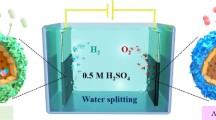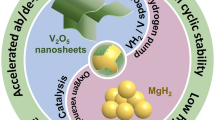Abstract
Constructing a S-scheme heterojunction with tight interface contact and fast charge transfer is beneficial to improving the photocatalytic hydrogen evolution performance. Herein, a unique one-dimensional (1D)/two-dimensional (2D) S-scheme heterojunction containing 1D Sb2S3 nanorods and 2D ZnIn2S4 with affluent sulfur vacancies (denoted as Sv-ZnIn2S4@Sb2S3) was designed. The introduced sulfur vacancy can promote the effective adsorption of H+ for the following interfacial hydrogen-evolution reaction. Furthermore, the larger contact area and stronger electron interaction between Sb2S3 and ZnIn2S4 effectively inhibits the recombination of photo-generated electron–hole pairs and abridges the migration distance of charges. As a result, the optimal Sv-ZnIn2S4@Sb2S3 sample achieves H2 evolution activity of 2741.3 mol·h−1·g−1, which is 8.6 times that of pristine ZnIn2S4 and 3.0 times that of the Sv-ZnIn2S4 samples. Based on the experimental result, the photo-reactivity S-scheme mechanism of hydrogen evolution from water splitting with Sv-ZnIn2S4@Sb2S3 is proposed. This work provides an effective method for developing S-scheme heterojunction composites of transition metal sulfide with high hydrogen evolution performance.
摘要
近年来, 过渡金属硫化物如MoS2、CdS、Cu2S、WS2等因其合适的带隙和和较高的吸收系数而备受关注, 适合作为可见光响应光催化剂。然而, 由于硫原子的化学状态不稳定, 二元金属硫化物, 比如Sb2S3, CdS等容易被光腐蚀, 从而导致其光催化活性不稳定。相比之下, 三元金属硫化物如ZnIn2S4等表现出良好的结构稳定性, 不过由于较快的电子-空穴复合速率及较低的量子效率, 其光催化性能还有待提高。基于上述考虑, 在最近提出的 S 型异质结的基础思想上, 我们首先确定了将 Sb2S3作为与ZnIn2S4复合的还原型光催化剂。本工作中, 我们首先通过低温溶剂热法制备了1D Sb2S3纳米纤维, 在此基础之上, 以油浴的方法制备获得 1D/2D 分等级且具有丰富硫空位的ZnIn2S4@Sb2S3 (Sv-ZIS@Sb2S3) S 型 (S-scheme) 异质结复合材料, 引入硫空位不仅可以有效地拓宽光吸收范围, 还能促进载流子的转移和分离。研究发现: 1D Sb2S3纳米纤维和2D的ZnIn2S4纳米片之间具有较大的接触面积和较强的电子相互作用, 可有效抑制光生电子-空穴对的复合。稳态光致发光光谱、瞬态光致发光光谱、光电流-时间响应谱和电化学阻抗谱等实验结果表明Sv-ZIS@Sb2S3复合材料相比于对应的单体具有更高的载流子传输和分离效率。最优比的Sv-ZIS@Sb2S3复合材料的析氢活性为2741.3 mol·h−1·g−1, 分别是是原始ZnIn2S4样品的8.6倍, 是Sv-ZnIn2S4样品的3.0倍。利用 X 射线光电子能谱 (XPS) 以及DFT计算等表征手段证实了半导体接触后内建电场的存在, 以及光照后载流子的移动方向, 这些都表明所制备的异质结是 S 型机理而不是传统的II型机理。 本工作为开发出具有高效析氢性能的过渡金属硫化物S型异质结复合材料提供了一种有效的方法。







Similar content being viewed by others
References
Takata T, Jiang JZ, Sakata Y, Nakabayashi M, Shibata N, Nandal V, Seki K, Hisatomi T, Domen K. Photocatalytic water splitting with a quantum efficiency of almost unity. Nature. 2020;581:411. https://doi.org/10.1038/s41586-020-2278-9.
Chen SS, Takata T, Domen K. Particulate photocatalysts for overall water splitting. Nat Rev Mater. 2017;2(10):17010. https://doi.org/10.1038/natrevmats.
Wan ST, Li HT, Ma ZH, Zhang HC, Zheng YZ. 2D/2D heterostructured MoS2/PtSe2 promoting charge separation in FTO thin film for efficient and stable photocatalytic hydrogen evolution. Rare Met. 2022;41(5):173. https://doi.org/10.1007/s12598-021-01954-3.
Qiu JY, Feng HZ, Chen ZH, Ruan SH, Chen YP, Xu TT, Su JY, Ha EN, Wang LY. Selective introduction of surface defects in anatase TiO2 nanosheets for highly efficient photocatalytic hydrogen generation. Rare Met. 2022;41(6):2074. https://doi.org/10.1007/s12598-021-01929-4.
Reddy DA, Kim EH, Gopannagari M, Kim Y, Kumar DP, Kim TK. Few layered black phosphorus/MoS2 nanohybrid: a promising co-catalyst for solar driven hydrogen evolution. Appl Catal B Environ. 2019;241:491. https://doi.org/10.1016/j.apcatb.2018.09.055.
Xu XY, Luo FT, Tang WS, Hu JG, Zeng HB, Zhou Y. Enriching hot electrons via NIR-photon-excited plasmon in WS2@Cu hybrids for full-spectrum solar hydrogen evolution. Adv Funct Mater. 2018;28(43):1804055. https://doi.org/10.1002/adfm.201804055.
Yang RJ, Mei L, Fan YY, Zhang QY, Zhu RS, Amal R, Yin ZY, Zeng ZY. ZnIn2S4-based photocatalysts for energy and environmental applications. Small Methods. 2021;5(10):2100887. https://doi.org/10.1002/smtd.202100887.
Weng B, Qi MY, Han C, Tang ZR, Xu YJ. Photocorrosion inhibition of semiconductor-based photocatalysts: basic principle, current development, and future perspective. ACS Catal. 2019;9:4642. https://doi.org/10.1021/acscatal.9b00313.
Liu DD, Ding WJ, Liu JJ, Zhang JT. Recent advances in defect chemistry of oxides for photocatalysis applications. Chin J Rare Metals. 2021;45(5):583. https://doi.org/10.13373/j.cnki.cjrm.XY20080036.
Li ZW, Hou JG, Zhang B, Cao SY, Wu YZ, Gao ZM, Nie XW, Sun LC. Two-dimensional Janus heterostructures for superior Z-scheme photocatalytic water splitting. Nano Energy. 2019;59:537. https://doi.org/10.1016/j.nanoen.2019.03.004.
Li Y, Qian J, Zhang MH, Wang S, Wang ZH, Li MS, Bai Y, An QY, Xu HJ, Wu F, Mai LQ, Wu C. Co-construction of sulfur vacancies and heterojunctions in tungsten disulfide to induce fast electronic/ionic diffusion kinetics for sodium-ion batteries. Adv Mater. 2020;32(47):2005802. https://doi.org/10.1002/adma.202005802.
Kondrotas R, Chen C, Tang J. Sb2S3 solar cells. Joule. 2018;2(5):857. https://doi.org/10.1016/j.joule.2018.04.003.
Cao L, Gao XW, Zhang B, Ou X, Zhang JF, Luo WB. Bimetallic sulfide Sb2S3@FeS2 hollow nanorods as high-performance anode materials for sodium-ion batteries. ACS Nano. 2020;14(3):3610. https://doi.org/10.1021/acsnano.0c00020.
Hu SJ, Jin L, Si WY, Wang BL, Zhu MS. Sulfur vacancies enriched 2D ZnIn2S4 nanosheets for improving photoelectrochemical performance. Catalysts. 2022;12(4):400. https://doi.org/10.3390/catal12040400.
Jing XD, Lu N, Huang JD, Zhang P, Zhang ZY. One-step hydrothermal synthesis of S-defect-controlled ZnIn2S4 microflowers with improved kinetics process of charge-carriers for photocatalytic H2 evolution. J Energy Chem. 2021;58:397. https://doi.org/10.1016/j.jechem.2020.10.032.
Gao DD, Xu JC, Wangle LX, Zhu BC, Yu HG, Yu JG. Optimizing atomic hydrogen desorption of sulfur-rich NiS1+x cocatalyst for boosting photocatalytic H2 evolution. Adv Mater. 2022;34:2108475. https://doi.org/10.1002/adma.202108475.
Pan JW, Zhang GX, Guan ZJ, Zhao QY, Li GQ, Yang JJ, Li QY, Zou ZG. Anchoring Ni single atoms on sulfur-vacancy-enriched ZnIn2S4 nanosheets for boosting photocatalytic hydrogen evolution. J Energ Chem. 2021;58:408. https://doi.org/10.1016/j.jechem.2020.10.030.
Wang XH, Wang XH, Huang JF, Li SX, Meng AL, Li ZJ. Interfacial chemical bond and internal electric field modulated Z-scheme Sv-ZnIn2S4/MoSe2 photocatalyst for efficient hydrogen evolution. Nat Commun. 2021;12(1):4112. https://doi.org/10.1038/s41467-021-24511-z.
Ma HY, Liu Y, Xiong R, Wei JH. Hetero-structured ZnIn2S4-NiO@MOF photo-catalysts for efficient hydrogen evolution. Chin Chem Lett. 2022;33(2):1042. https://doi.org/10.1016/j.cclet.2021.08.048.
Ayappana C, Jayaramana V, Palanivela B, Pandikumarb A, Mani A. Facile preparation of novel Sb2S3 nanoparticles/rod-like α-Ag2WO4 heterojunction photocatalysts: continuous modulation of band structure towards the efficient removal of organic contaminants. Sep Purif Technol. 2020;236:116302. https://doi.org/10.1016/j.seppur.2019.116302.
Su TM, Men CZ, Chen LY, Chu BX, Luo X, Ji HB, Chen JH, Qin ZZ. Sulfur vacancy and Ti3C2Tx cocatalyst synergistically boosting interfacial charge transfer in 2D/2D Ti3C2Tx/ZnIn2S4 heterostructure for enhanced photocatalytic hydrogen evolution. Adv Sci. 2022;9(4):2103715. https://doi.org/10.1002/advs.202103715.
Yang YC, Liu Y, Wei JH, Pan CX, Xiong R, Shi J. Electrospun nanofibers of p-type BiFeO3/n-type TiO2 hetero-junctions with enhanced visible-light photocatalytic activity. RSC Adv. 2014;4(60):31941. https://doi.org/10.1039/c4ra04258a.
Yang WL, Zhang L, Xie JF, Zhang XD, Liu QH, Yao T, Wei SQ, Zhang Q, Xie Y. Enhanced photoexcited carrier separation in oxygen-doped ZnIn2S4 nanosheets for hydrogen evolution. Angew Chem Int Ed. 2016;55(23):6716. https://doi.org/10.1002/anie.201602543.
Chen F, Feng HF, Luo W, Wang P, Yu HG, Fan JJ. Simultaneous realization of direct photodeposition and high H2-production activity of amorphous cobalt sulfide nanodot-modified rGO/TiO2 photocatalyst. Rare Met. 2021;40(11):3125. https://doi.org/10.1007/s12598-021-01755-8.
Huang LS, Zhang LX, Bao DY, Jiang XQ, Li JH, Sun XS. Hybrid photo-catalyst of Sb2S3 NRs wrapped with rGO by C-S bonding: ultra-high photo-catalysis effect under visible light. Appl Surf Sci. 2020;526:146742. https://doi.org/10.1016/j.apsusc.2020.146742.
Xiao Y, Wang H, Jiang YH, Zhang WL, Zhang JM, Wu XY, Liu ZC, Deng W. Hierarchical Sb2S3/ZnIn2S4 cor-shell heterostructure for highly efficient photocatalytic hydrogen production and pollutant degradation. J Colloid Interf Sci. 2022;623:109. https://doi.org/10.1016/j.jcis.2022.04.137.
Zhang LY, Zhang JJ, Yu HG, Yu JG. Emerging S-Scheme photocatalyst. Adv Mater. 2022;34:2107668. https://doi.org/10.1002/adma.202107668.
Li SJ, Cai MJ, Liu YP, Zhang JL, Wang CC, Zang SH, Li YJ, Zhang P, Li X. In situ construction of a C3N5 nanosheet/Bi2WO6 nanodot S-scheme heterojunction with enhanced structural defects for the efficient photocatalytic removal of tetracycline and Cr(VI). Inorg Chem Front. 2022;9(11):2479. https://doi.org/10.1039/d2qi00317a.
Li W, Ma HY, Liu ZF, Li JJ, Fang PF, Xiong R, Pan CX, Wei JH. In situ electronic redistribution tuning of ZnIn2S4 nanosheets on NiCo2S4 hollow tube for boosted photocatalytic hydrogen evolution. Appl Surf Sci. 2022;598:153801. https://doi.org/10.1016/j.apsusc.2022.153801.
Xu QL, Zhang LY, Cheng B, Fan JJ, Yu JG. S-scheme heterojunction photocatalyst. Chem. 2020;6(7):1543. https://doi.org/10.1016/j.chempr.2020.06.010.
Acknowledgements
This study was financially supported by the National Natural Science Foundation of China (Nos. 12075174 and 91963207) and the National Key Research and Development Program of China (No. 2022YFA1602701).
Author information
Authors and Affiliations
Corresponding author
Ethics declarations
Conflict of interests
The authors declare that they have no conflict of interest.
Supplementary Information
Below is the link to the electronic supplementary material.
Rights and permissions
Springer Nature or its licensor (e.g. a society or other partner) holds exclusive rights to this article under a publishing agreement with the author(s) or other rightsholder(s); author self-archiving of the accepted manuscript version of this article is solely governed by the terms of such publishing agreement and applicable law.
About this article
Cite this article
Li, W., Li, JJ., Liu, ZF. et al. Fast charge transfer kinetics in Sv-ZnIn2S4/Sb2S3 S-scheme heterojunction photocatalyst for enhanced photocatalytic hydrogen evolution. Rare Met. 43, 533–542 (2024). https://doi.org/10.1007/s12598-023-02419-5
Received:
Revised:
Accepted:
Published:
Issue Date:
DOI: https://doi.org/10.1007/s12598-023-02419-5




